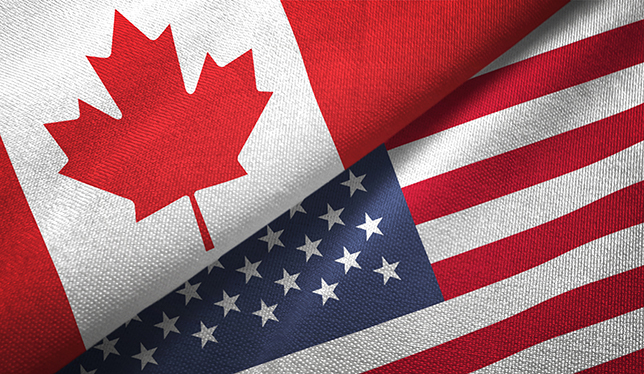Canada vs. the U.S.: where should you attend grad school?
An exploration of some of the nuances between postsecondary education in the two countries, as well as some of the intangibles that are often not thought about.

So you’ve decided to pursue graduate school, and as you do a deeper dive into the different program websites, you will likely start to take note of some features: institution and program size, cost, location, application and program requirements, and potential supervisors (or advisors as they are typically referred to in the U.S.).
What might be missing from this picture are some of the nuances in these concrete details, as well as some of the intangibles, such as what your experience might be like during and after graduation. The U.S. remains a popular choice, although some suggest there has been a decline in interest, based on a Council of Graduate Schools survey showing a four percent decline in international student graduate applications between fall 2017 and fall 2018. Canada, meanwhile, has become increasingly popular (Statistics Canada reported that enrolment in public colleges and universities was up 1.2 percent in 2016-2017, with the number of international students increasing at a higher rate than that of Canadian students). With this in mind, it’s worth teasing out some of the less easily discernible differences between studying in these two countries.
Funding for your master’s or doctoral studies
The tuition differences between local/domestic residents versus international students in Canada, or in-state versus out-of-state and international fees in the U.S. may be substantial. For example, at McGill University, if you are a Quebec resident, then the tuition and fees for a full-time master’s program is ~$4,430 (CAD) for the fall and winter terms. For a non-Quebec Canadian, it would cost ~$9,826 (CAD), and for international students, it would be a little over ~$20,000 (CAD). In the U.S., at a well-regarded public institution like University of California, Los Angeles (UCLA), one year’s tuition and fees for California residents are ~$16,847 (USD), and ~$31,949 for non-California residents. At a private university like Stanford, the tuition alone for the academic year is estimated to be ~$34,110 (USD).
But the “sticker price” versus what you end up paying may, in fact, vary. At the doctoral level, some elite institutions in the U.S. are able to provide their students with full funding for the duration or a significant portion of their studies. Even in circumstances where the tuition is high, it is not unusual for both American and Canadian graduate programs to help identify opportunities for teaching assistant (TA) or research assistant (RA) work. However, you would be well-served to inquire how long you would be eligible for any tuition waivers (find out when does it would time out), if there are ample TA or RA positions, and what other fellowships or funding sources that you could apply to for support (find out the success rate). For example, in Canada, there may be fellowships/funding awards that are limited to Canadian citizens, but there are also generous (though highly competitive) sources of funding that accept applications regardless of residency status.
Is a master’s degree required for entry into a doctoral program?
One difference that might already be on your radar is that GRE tests are often required for graduate programs in the U.S., whereas this is not generally the case in Canada. Another difference that may not always be obvious is that in the Canadian context, doctoral programs will often require that you have a master’s degree to gain entry; in the U.S., it is not always necessary. One reason is because doctoral programs in the U.S. might include more coursework that could overlap with the requirements for a master’s degree. In Canada though, some programs may have a fast-track option to the PhD degree after the first year of the master’s program. The lack of a master’s degree requirement in certain doctoral programs in the U.S. might also coincide with the granting of a “masters-en-route” after one meets certain program milestones. This kind of degree can be advantageous for those who want an extra credential as they pursue their doctorate, or may be useful should one leave the doctoral program without completing the dissertation.
Campus and community life
The location of a university can have an impact on its campus life and its relationship to the surrounding community. If you are in a town whose population swells with the start of the academic year (e.g., Ann Arbor, Michigan or Kingston, Ontario) versus a bustling metropolis (e.g., Chicago or Montreal), the campus culture and its relationship to the surrounding area will feel different. By virtue of the sheer number of universities in the U.S., you might find many public institutions to be in suburban or rural settings, which creates campuses that are likely more self-contained than ones in big cities. While this may not rank as high in your decision making process as cost/funding, alumni outcomes, supportive faculty, or curriculum, try to get a feel for your life and community both inside and outside of the program.
Some other things to ponder during your institution exploration:
- Does your department you’re applying to create opportunities for exchange and support amongst peers?
- Are there research centres that you can lean on for professional development and networking?
- Does campus culture revolve around sports?
- Is the university more likely to support an “alternative spring break” where you donate your time to a community organization?
- Do eating clubs or fraternities and sororities play a significant role in social life?
Career prospects in your industry
If you are not a Canadian or U.S. citizen, and you are hoping that a master’s or doctoral degree might enable you to work in your industry, you need to find out the work permit or residency process once you graduate. It has been argued that Canada’s immigration policy might play a role in increasing international student enrolment, but will you need to learn another language to be competitive? How might location play a role in terms of whether your partner can find meaningful work? How could your university’s reputation and network be put to your advantage? What does the university offer in terms of skills development and career planning so that you can launch your career after graduation?
Featured Jobs
- Sociology - Tenure-Track Position (Crime and Community)Brandon University
- Medicine - Associate or Full Professor Professor (Kidney Health)Université de Montréal
- Engineering - Assistant or Associate Professor (Robotics & AI)University of Alberta
- Architecture - Assistant Professor (environmental humanities and design)McGill University
- Finance - Faculty PositionUniversity of Alberta















Post a comment
University Affairs moderates all comments according to the following guidelines. If approved, comments generally appear within one business day. We may republish particularly insightful remarks in our print edition or elsewhere.
1 Comments
Confused by this article because a number of the differences that are alluded to are simply not true. It is not at all uncommon for Canadian universities to offer full, multi-year guaranteed funding for full-time Ph.D. students – just like in the US. The article also suggests that there are no direct-entry Ph.D. programs in Canada – which is incorrect. As in the US, direct-entry programs are more common in some discipline areas than in others – but if excellent undergraduate students are looking for a direct entry into a doctorate should look in Canada as well as the U.S.
There are, of course, differences between graduate education between Canada and the United States – in some program areas, for example, doctoral students are expected to complete more coursework in the United States than in peer Canadian universities. More importantly, there are major differences between programs by institution in both countries – so the best advice is to spend time searching out the best programs (and the best possible supervisors) in both countries and look for the very best matches given the research interests of the student and the strengths of the various programs.